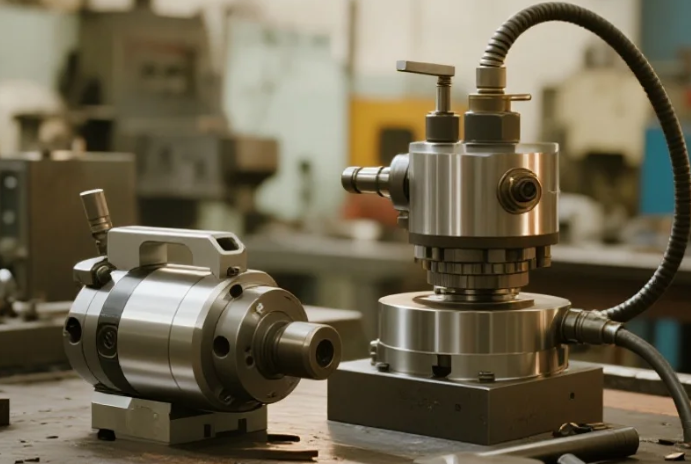The high-pitched hiss of compressed air cuts through the hum of your CNC mill. You watch as a pneumatic clamp (powered by compressed air) snaps shut, securing a steel block in seconds. It feels quick, almost eager.
Across the aisle, a hydraulic clamp (powered by oil pressure) engages with a deep, resonant thunk. Its movement is deliberate, powerful, leaving no doubt about its grip on that massive cast iron part.
You need new clamps for a demanding production run. That familiar question surfaces: Air or oil? Let’s cut through the fog.
Core Differences: Speed vs. Power
At their core, both systems aim to hold workpieces rock-solid.
-
Pneumatics rely on shop air—convenient and fast. Think of it like a sprinter: quick off the mark.
-
Hydraulics use incompressible oil, delivering immense, unwavering force—more like a weightlifter holding a record lift.
Key Considerations:
-
Clamping Force Consistency
-
Pneumatic pressure fluctuates with line pressure and leaks.
-
Hydraulics lock in force with near-perfect rigidity.
-
Why does this matter? Imagine precision boring a delicate aluminum housing. Any tiny shift ruins it. Hydraulics excel here.
-
-
Speed vs. Strength
-
Loading dozens of small parts per hour? Pneumatics win on cycle time.
-
Need massive holding power in a tight space? Hydraulics deliver force a pneumatic cylinder three times its size couldn’t match.
-
-
Creep (Gradual Force Loss)
The Trade-Offs: Convenience vs. Performance
Here’s the kicker: Convenience isn’t free.
Pneumatics: Quick & Simple
✔ Plug-and-play (hooks into existing air lines)
✔ Lower upfront cost
✖ Battles moisture (needs dryers & filters)
✖ Air leaks (listen for that tell-tale hiss!)
✖ Less efficient (compressed air wastes energy)
Hydraulics: Power & Precision
✔ Unmatched force & rigidity
✔ No creep, even under heat/load
✔ Better force-to-size ratio
✖ Needs a power unit (pump, reservoir, cooling)
✖ Messy leaks (oil spills = safety/environmental risk)
✖ Higher maintenance (contamination kills valves)
How to Decide? Ask These Questions
Break it down ruthlessly:
-
Force & Rigidity Needed?
-
Brute strength (milling tough alloys)? → Hydraulic
-
Lighter duty, fast cycling? → Pneumatic
-
-
Environment & Duty Cycle?
-
Dirty, wet shop? → Pneumatics tolerate grime better
-
Clean room, 24/7 heavy load? → Hydraulics endure
-
-
Infrastructure & Budget?
-
Got dry air lines? → Pneumatics integrate easily
-
Prepared for hydraulic power unit costs? → Hydraulics win on power density
-
-
Safety & Control?
-
Hydraulics lock position without constant pressure (critical fail-safe).
-
Pneumatics need steady air supply.
-
Final Verdict: No Universal Winner
-
Choose Pneumatics for:
-
Speed, simplicity, moderate force
-
Fast cycling, lower initial cost
-
-
Choose Hydraulics for:
-
Unbeatable power & rigidity
-
Extreme precision, heavy-duty, or harsh environments
-
Listen beyond the hiss and the thunk. What does your production truly demand? Choose the grip that won’t let you down.
Your bottom line depends on it.
Post time: Aug-14-2025





